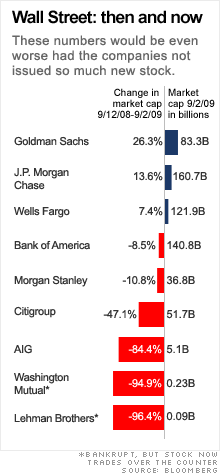Lessons of the crash of '08
It would be nice to think we've learned something from the near-death of the world's economic system. But, sorry to say, Wall Street will always be Wall Street.
 |
| Allan Sloan, senior editor at large |

(Fortune Magazine) -- It's been 12 months since Lehman Brothers failed, setting off a chain reaction that came horrifyingly close to destroying the world's financial system.
That anniversary makes this a convenient time to take a deep breath, look back at l'affaire Lehman, and see what we can learn from the past turbulent year.
How has Wall Street changed since Lehman went broke last Sept. 15? What are the lessons? And what does it all mean to those of us who aren't directly involved?
Even though some once-iconic names have vanished and others are crippled shadows of their former selves, Wall Street hasn't really changed all that much. It still operates on the principle of taking care of itself first, really big and important customers second, everyone else last.
Among the healthy firms -- which are poaching talent right and left from the dead and weak -- fat profits, swagger, and the delicious prospect of juicy bonuses (regulators' income-limitation attempts notwithstanding) are back in style.
Business is good and likely to get better because of the huge demand for capital-raising services in a world that's suffered trillions in losses over the past two years. This makes Wall Street's prospects far brighter than those of ordinary people trying to cope with losses in their stock portfolios and home-equity value. Not to mention job losses.
Now, let's talk about what we've learned. First, the fact that regulators and central bankers couldn't keep Lehman alive -- top honchos like former Treasury Secretary Hank Paulson say that, and I'll take them at their word -- shows us that the world's capital markets have become increasingly powerful relative to central banks. So much for the idea of central bankers ruling the roost.
The second lesson involves what I call the secret handshake factor. After having the world come close to melting down because of Lehman's collapse, governments are more determined than ever to protect the surviving multinational financial giants (which happens to help us). It's like being part of a secret club: No matter what they say to one another in public, giant institutions and their governments both know that the institutions will be treated with loving care.
In the U.S., for instance, various arms of the government have lavished enormous subsidies on financial institutions to keep them -- and the financial system -- afloat by guaranteeing their debts, giving them access to ultra-cheap capital, and helping restart markets (such as converting loans into securities) that are extremely lucrative for Wall Street. No intelligent politician or regulator wants to risk Lehman II by having another giant firm fail.
The Lehman collapse, which made chief executive Dick Fuld a household name, came as something of a surprise because Lehman was so much bigger than Bear Stearns, which the Federal Reserve and Treasury had bailed out six months earlier lest its failure lead to a worldwide meltdown.
The Fed and Treasury brokered a sale to J.P. Morgan Chase (JPM, Fortune 500) that bailed out Bear creditors, got stockholders $10 a share for shares that were essentially worthless, and stuck taxpayers with the risk on $29 billion of Bear assets that Morgan considered too risky.
Why did the government bail out the smaller Bear in the name of saving the world financial system but let Lehman fail six months later?
"The U.S. government didn't let Lehman fail, it didn't have the authority to save it," Treasury Secretary Tim Geithner told Fortune in an interview. Geithner, then head of the New York Federal Reserve Bank, played a key role in the Bear and Lehman deals, getting his current job in early 2009.
"People think that the government chose to let Lehman fail because they wanted to teach people a lesson," Geithner said, but they're wrong. "The fundamental constraint was that the Treasury at that point had no authority" to put capital into Lehman, and "the central bank did not have the ability to fill a capital hole."
The idea of the Treasury and the Fed being constrained feels odd, given how inventive they were at creating a way to let investment banks access some of the Fed's bank-only lending programs shortly after Bear failed, and how they quickly invented a dozen new programs to pump money into the financial system.
But Geithner said there was a full-scale run -- as in bank run -- underway at Lehman. Because there was no buyer willing to assume most of Lehman's obligations, as Morgan did for Bear, the Fed would have been risking unlimited losses because Lehman didn't have enough collateral to back the 12- or 13-digit loans -- hundreds of billions or trillions of dollars -- it would have taken to meet the run.
In essence, then, the financial markets overwhelmed the Fed's resources.
Geithner says regulators and governments expected bad things from the Lehman collapse, but things proved even worse than they feared.
Among the nasty surprises was that the Reserve Primary fund, stuck with Lehman paper, became the first big money-market mutual fund to "break the buck." That terrified millions of average people and forced the government to guarantee money-fund accounts to avoid a deposit run that could have destroyed short-term financial markets.
There was also the beginning of potentially catastrophic runs at Goldman Sachs (GS, Fortune 500) and Morgan Stanley (MS, Fortune 500) as hedge funds that used them as "prime brokers" began withdrawing assets to avoid the fate of Lehman prime-brokerage customers who had their assets frozen in the bankruptcy.
So the Fed, on an emergency basis, had to let Goldman and Morgan become bank companies to give them access to the full array of borrowing tools available to banks. The prospect of either firm -- or both -- failing was horrifying.
Lehman was in fact too big to fail without dire consequences. It was the beta test for the "too big to fail" doctrine. And the doctrine was validated.
The U.S. government has been keeping the financial system functioning, at enormous expense to current and future taxpayers. The idea is for Wall Street to step up lending to people and businesses, making money for itself and helping the economy in the process. As one Street guy quipped, "Greed got us into this, and greed will get us out."
Permanent change? Forget it. Despite all the bloviation about our current mess having transformational qualities, I expect Wall Street to keep acting like Wall Street, and for the government -- and most people -- to put up with it because there's no choice.
Geithner's solution, part of the Obama administration's financial regulatory-reform proposal, is to make key firms keep so much capital on hand that failure is remote, and to allow the government to liquidate them in case the unthinkable happens.
Forgive my skepticism, but I think the only solution is to break up some of the giant firms, and make sure no firm is ever again too big to fail.
Alas, as memories of the worldwide panic of a year ago fade, the chances of Geithner's proposals (or mine) taking effect are slim and none. Lehman or no Lehman. ![]()
-
 The retail giant tops the Fortune 500 for the second year in a row. Who else made the list? More
The retail giant tops the Fortune 500 for the second year in a row. Who else made the list? More -
 This group of companies is all about social networking to connect with their customers. More
This group of companies is all about social networking to connect with their customers. More -
 The fight over the cholesterol medication is keeping a generic version from hitting the market. More
The fight over the cholesterol medication is keeping a generic version from hitting the market. More -
 Bin Laden may be dead, but the terrorist group he led doesn't need his money. More
Bin Laden may be dead, but the terrorist group he led doesn't need his money. More -
 U.S. real estate might be a mess, but in other parts of the world, home prices are jumping. More
U.S. real estate might be a mess, but in other parts of the world, home prices are jumping. More -
 Libya's output is a fraction of global production, but it's crucial to the nation's economy. More
Libya's output is a fraction of global production, but it's crucial to the nation's economy. More -
 Once rates start to rise, things could get ugly fast for our neighbors to the north. More
Once rates start to rise, things could get ugly fast for our neighbors to the north. More








